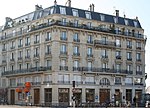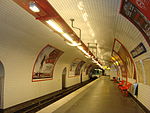La Chapelle (Paris Métro)
Paris Métro line 2Paris Métro stations in the 10th arrondissement of ParisParis Métro stations in the 18th arrondissement of ParisRailway stations in France opened in 1903

La Chapelle (French pronunciation: [la ʃapɛl]) is a station on Paris Métro Line 2, on the border of the 10th and 18th arrondissements above the Boulevard de la Chapelle. The station is connected to the Gare du Nord and the Gare du Nord Métro station on lines 4 and 5.
Excerpt from the Wikipedia article La Chapelle (Paris Métro) (License: CC BY-SA 3.0, Authors, Images).La Chapelle (Paris Métro)
Paris 10th Arrondissement (Paris)
Geographical coordinates (GPS) Address Nearby Places Show on map
Geographical coordinates (GPS)
| Latitude | Longitude |
|---|---|
| N 48.884411 ° | E 2.360288 ° |
Address
75010 Paris, 10th Arrondissement (Paris)
Ile-de-France, France
Open on Google Maps










